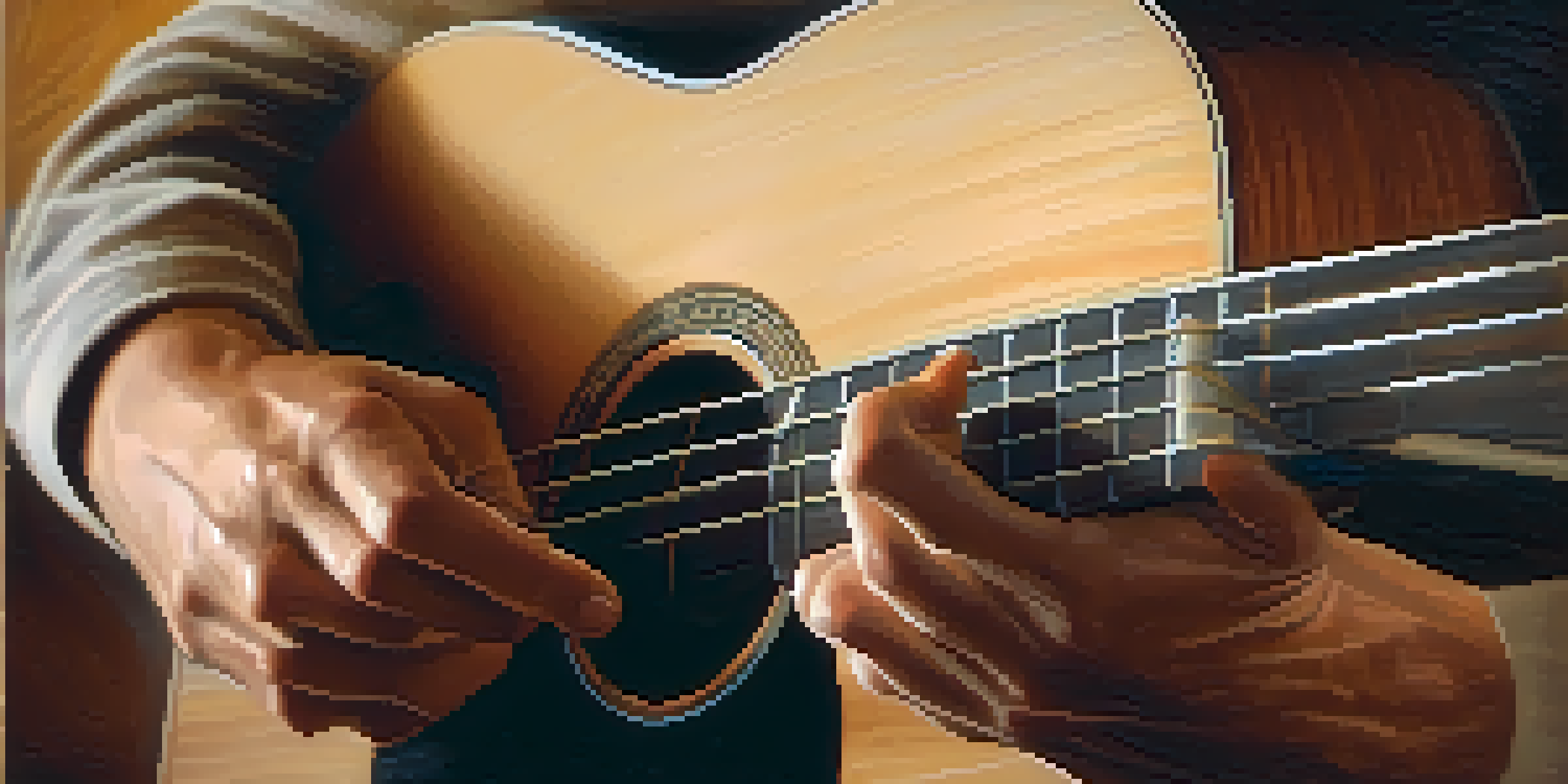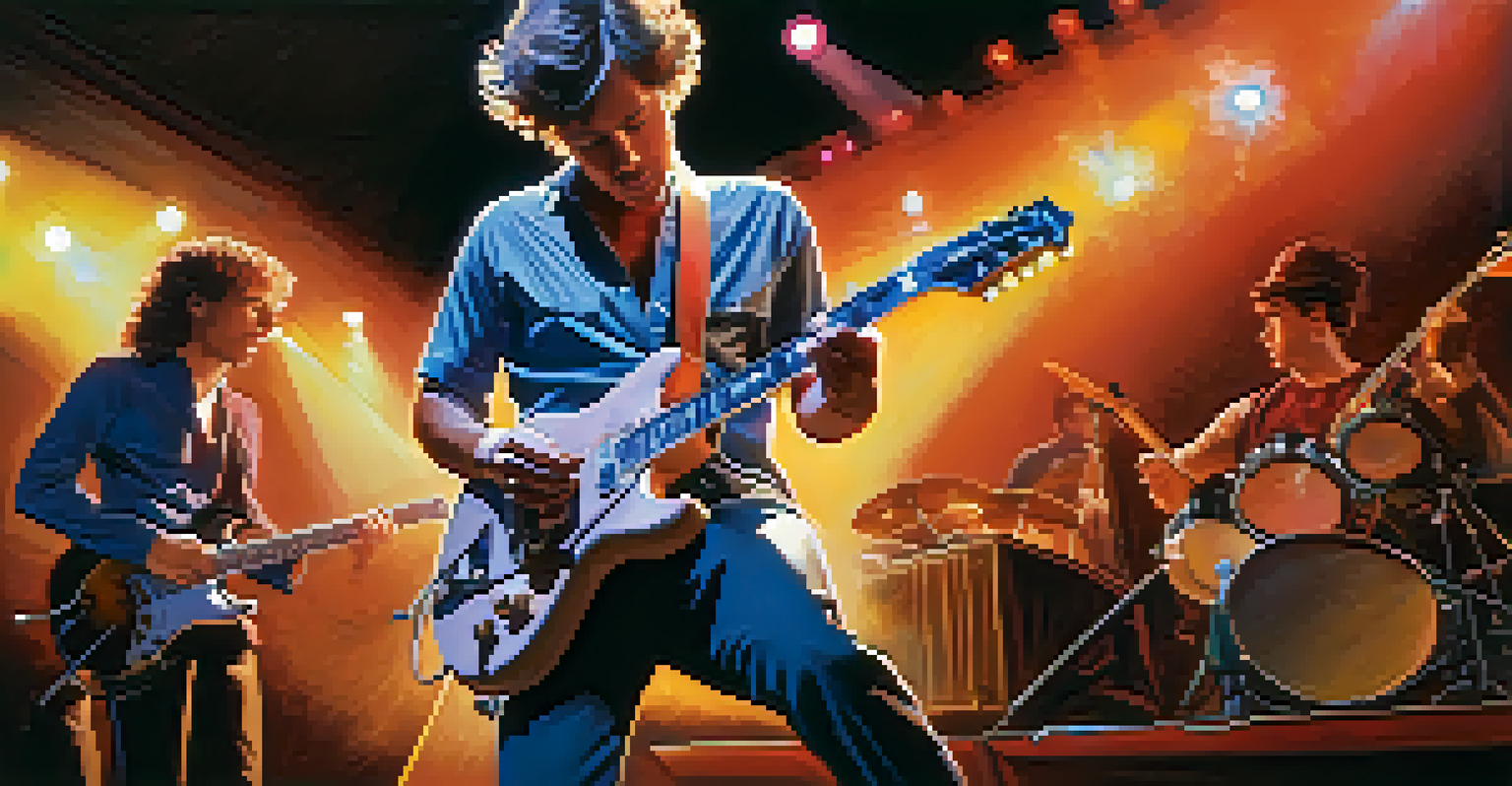Emotional Storytelling Through Guitar: A Deep Dive

The Power of Emotion in Music and Storytelling
Music is an incredible medium that transcends words, allowing artists to express feelings in a way that language sometimes cannot. When it comes to guitar, the instrument can evoke a wide range of emotions—from joy to sorrow, nostalgia to hope. This connection between emotion and storytelling is vital; it helps listeners relate to the narrative being presented.
Music is the shorthand of emotion.
Consider how a single strum of a guitar can change the atmosphere in a room. A soft, gentle melody might conjure feelings of peace, while a powerful riff can trigger excitement or passion. This emotional versatility is what makes the guitar a perfect tool for storytelling in music.
Ultimately, the ability of guitar music to resonate emotionally is what draws people in, making them feel and experience the stories being told. It’s not just about the notes played but the feelings they inspire, creating a rich tapestry of narrative through sound.
Crafting an Emotional Narrative with Guitar Techniques
To effectively tell a story with the guitar, musicians often employ various techniques that enhance the emotional impact of their music. Techniques such as fingerpicking, bending notes, and using vibrato can convey deep feelings and nuances. For instance, fingerpicking can create an intimate atmosphere, inviting listeners into a personal narrative.

Moreover, the choice of scales and chord progressions plays a significant role in setting the emotional tone. Minor scales might evoke feelings of melancholy, while major scales can bring about joy and optimism. By understanding these musical elements, guitarists can craft narratives that resonate on a deeper level.
Emotion Drives Music and Storytelling
Music, especially through guitar, expresses emotions that enhance storytelling, connecting listeners to the narrative.
The combination of these techniques allows musicians to effectively illustrate their stories, making them relatable and emotionally charged. Each note becomes a brushstroke in a painting, capturing the essence of the narrative they wish to share.
Examples of Emotional Storytelling in Guitar Music
Many iconic songs showcase the power of emotional storytelling through guitar. Take Eric Clapton's 'Tears in Heaven,' for instance; the poignant lyrics paired with the gentle guitar work create a heartfelt narrative about loss and longing. The way Clapton plays the guitar mirrors the emotional weight of the lyrics, making the song resonate deeply with listeners.
The guitar is a miniature orchestra in itself.
Similarly, the legendary Jimi Hendrix used his guitar to tell stories of love, freedom, and rebellion. In 'The Wind Cries Mary,' Hendrix’s use of expressive bends and rich chords paints a vivid picture of yearning and reflection, demonstrating how a guitar can serve as a voice for complex emotions.
These examples illustrate that great guitar music is more than just technical skill; it’s about connecting with an audience on an emotional level. Through their stories, these musicians invite listeners to feel along with them, creating a shared experience that lingers long after the last note.
The Role of Lyrics in Enhancing Guitar Storytelling
While guitar techniques are crucial for emotional storytelling, lyrics play an equally important role in enhancing the narrative. Thoughtful lyrics can deepen the meaning behind the music, allowing listeners to connect more fully with the story. For instance, Bob Dylan often paired his intricate guitar work with poignant lyrics that challenged societal norms, creating a powerful narrative experience.
When lyrics complement the emotional tone of the guitar, they can elevate the storytelling to new heights. The synergy between the two elements creates a richer tapestry of sound and meaning, enabling the audience to engage with the story on multiple levels.
Guitar Techniques Amplify Emotion
Techniques like fingerpicking and chord progressions help musicians convey deeper feelings, enriching their narratives.
In essence, lyrics and guitar work together like two dancers in a beautifully choreographed routine, each enhancing the other’s expression. This collaboration transforms a simple song into a multifaceted narrative that resonates long after it’s heard.
The Influence of Cultural Context on Guitar Storytelling
Cultural context plays a significant role in shaping the emotional storytelling of guitar music. Different cultures have unique musical traditions that influence how stories are told through instruments. For example, flamenco guitar is rich with history and emotion, often reflecting themes of love, struggle, and passion specific to Spanish culture.
Additionally, the blues genre, rooted in African American history, tells stories of hardship and resilience through its distinctive guitar riffs and melodies. The emotional depth found in these stories often resonates with listeners, as they reflect universal human experiences, transcending cultural boundaries.
By understanding the cultural background of guitar music, listeners can appreciate the layers of emotion embedded in the narratives. This awareness adds depth to the storytelling, allowing for a more profound connection to the music and its origins.
How to Connect Your Emotions with Guitar Playing
If you're a guitarist looking to enhance your storytelling ability, start by exploring your own emotions. Reflect on moments in your life that have evoked strong feelings, as these experiences can serve as a foundation for your music. Whether it’s joy, sorrow, or nostalgia, tapping into your personal narratives can bring authenticity to your playing.
Practicing improvisation can also help you discover how to express emotions through your guitar. Allow yourself to play without a specific structure, focusing instead on how the sounds make you feel. This freedom can lead to unexpected emotional connections and narratives that resonate with you and your audience.
Cultural Context Shapes Musical Stories
Cultural backgrounds influence how guitar music tells stories, embedding unique emotional layers that resonate universally.
Lastly, don’t forget to listen to a diverse range of guitarists and genres. Analyze how they convey emotions through their music, and experiment with incorporating those techniques into your own playing. By doing so, you'll develop a unique voice that tells your story through the power of the guitar.
The Future of Emotional Storytelling in Guitar Music
As technology evolves, the landscape of guitar music and emotional storytelling continues to change. With the advent of digital tools, musicians can now experiment with soundscapes and production techniques to create rich, immersive narratives. This evolution opens up new avenues for storytelling, allowing artists to push the boundaries of traditional guitar music.
Moreover, the rise of online platforms has made it easier for musicians to share their stories with a global audience. Social media and streaming services allow artists to connect with listeners in ways that were previously unimaginable, fostering a community of shared experiences and emotional exchanges.

Looking ahead, the future of emotional storytelling through guitar is bright and full of potential. As musicians continue to innovate and explore new ways to express their narratives, the power of the guitar will remain a vital tool for connecting people through shared emotions and experiences.